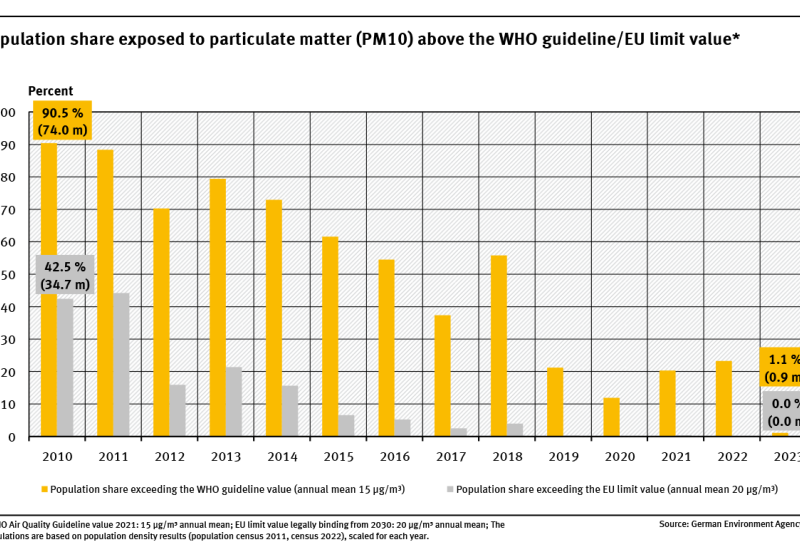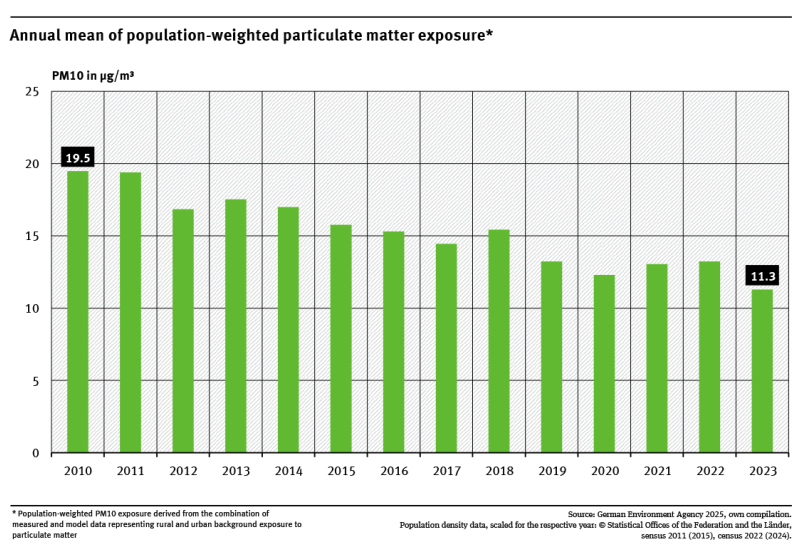Between 2010 and 2023, the proportion of the population exposed to annual average PM10 concentrations above the WHO guideline value of 15 µg/m³ decreased from 90.5 % to 1.1 %.Since 2019, the share of the population exposed to PM10 levels above the EU limit value of 20µg/m³ (legally binding from 2030) has been below 0.5 %—and in 2023, it was 0 %.Current measures should be mainta... read more
air pollution
Umwelt-Indikator
Indicator: Population-weighted particulate matter exposure (PM10)
Population-weighted exposure to PM10 in Germany was significantly lower in 2023 than in 2010.In 2023, the population-weighted PM10 exposure was 11.3 µg/m³—approximately 42 % lower than in 2010.This decline in exposure is due to decreasing emissions from stationary sources (such as power plants, waste incineration facilities, residential heating, and industrial plants) as well as measures implement... read more
Indicator: Population exposure to particulate matter (PM2.5)
The proportion of the population exposed to annual average PM2.5 concentrations above 10 µg/m³ (the EU limit value legally binding from 2030) has decreased significantly in Germany since 2010.However, between 2010 and 2023, nearly the entire population was exposed to fine particulate matter concentrations exceeding the current WHO guideline value for PM2.5 (5 µg/m³ annual average).Therefore, furth... read more
Water
Maritime shipping
More and larger ships are sailing the world's oceans. Due to their high tonnages, ocean-going vessels can be a comparably environment-friendly means of transport. There is still considerable potential to design and construct them in such a way that they pollute the environment less. Proposals need to be developed and implemented at all levels of maritime policy.. read more
Air
Air pollutants at a glance
The composition of the air is affected by humans. Many components of the air are, above a certain concentration, a threat to humans and animals and affect plants, water bodies, soils and even buildings and materials. read more
Air
National Integrated Assessment Modelling (NIAM)
NIAM is a network affiliated to the UNECE Air Convention that aims at bringing together integrated assessment modellers from different countries investigating strategies to reduce air pollution and its impacts. We want to share experience on technical aspects of modelling, on the tools and data we use and exchange information about the analysis of national measures and policies. Moreover, NIAM aim... read more
Health
Emissions from wood and coal burning stoves in residential areas
Smoke from house chimneys can lead to unpleasant odours in the neighbourhood and be harmful to health. read more
Air
Air quality maps: Background information
How are the German Environment Agency's maps of Germany's current air pollution and ozone concentration forecasts drawn up? We explain here in brief. read more







